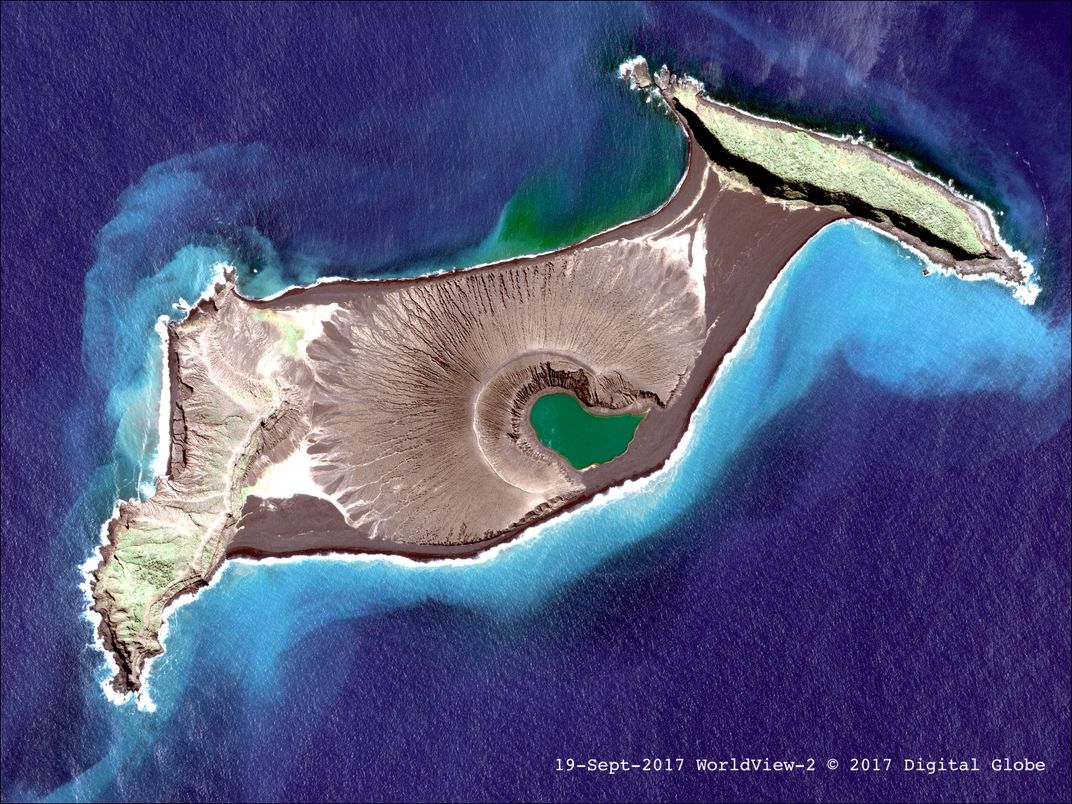How the Rapidly Changing Shape of This New Island Could Teach Us About Mars
Hunga Tonga-Hunga Ha’apai has lasted longer than it should, and the processes that formed the island are of interest to NASA
/https://tf-cmsv2-smithsonianmag-media.s3.amazonaws.com/filer/0d/ce/0dce4b1f-39c0-45ee-8feb-37af4bf7bfd6/hunga.jpg)
In December, 2014, an underwater volcano in the island nation of Tonga erupted. And by January of 2015, the mounting piles of volcanic rock created a circular island.
Dubbd Hunga Tonga-Hunga Ha'apai, the island is just a few kilometers wide and was connected to one of two existing islands near the volcano. But the landscape was interesting, with 400-foot-tall cliffs and a crater in the middle. Authorities warned people away from visiting the new landmass since many of these temporary structures erode away in a matter of months, reports Michael Greshko at National Geographic. But almost three years later, this fledgling island is still standing, and a new analysis suggests that the unusual speck of land may persist another six to 30 years. Even more exciting: it may offer new insights into Mars.
Jim Garvin chief scientist at NASA's Goddard Space Flight Center told the story of the unusual island last Monday during a presentation at the American Geophysical Union's annual meeting in New Orleans. The researchers believe the island is different from other volcanic islands, according to a press release. They believe that the interactions of the warm seawater and ash spewing from the volcano created a material called "tuff" that hardened along the shoreline. So unlike other ephemeral volcanic islands whose rocky and ashy shorelines slowly wash away, the tuff has given the new island some extra stability. It’s the same process that created the island of Surtsey in Iceland in 1963, reports Greshko, lending the process the name “surtseyan eruption.”
That’s not to say Hunga Tonga-Hunga Ha'apai is particularly stable. As Maddie Stone at Earther explains, researchers have have kept a close eye on the landmass its formation—and have spotted some dramatic changes. By April 2015, the cliffs around the crater in the center of the island collapsed and eroded, leaving a central lake on the island. Weeks later, a sandbar closed off the crater lake from the open ocean, protecting it from wave erosion.

At the same time, a peninsula connecting Hunga to another island has grown over time, combining all three into one large(ish) land mass. The central island is expected to last as long as the cone of tuff surrounding the lake holds, which could be six years or could be several decades, depending erosion and wave action. “This island is fighting for its life,” Garvin says in the presentation, Stone reports. “And our predictions suggest we’ve got potentially another decade to watch this thing evolve from space.”
The island is also interesting for what it could tell us about similar structures on other planets. “We see things that remind us of this kind of volcano at similar scales on Mars,” Garvin tells Kenneth Chang at The New York Times. “And literally, there are thousands of them, in multiple regions.”
According to the press release, those ancient, extinct volcanoes on Mars appear to have formed while surrounded by water, making them prime locations to search for life. The combination of volcanic heat, gases and seawater has proven to be a strong recipe for life on Earth, especially at hydrothermal vents. "Islands like this might have worked on Mars two or three billion years ago—lakes and small seas filling depressions, persistent surface waters," Garvin says. “[It’s] stuff we really strive to understand because it could have produced the conditions necessary for microbial life.”